

Adolescent Development Index - Taking Center Stage - Act II (CA Dept of Education) California Department of Education Taking Center Stage – Act II (TCSII) A Portal for Middle Grades Educators Taking Center Stage California Department of Education Taking Center Stage – Act II Search.

Why Every Student Should Be In a 1:1 Classroom — Emerging Education Technologies. 1 to 1 Classroom Teacher Mark Pullen shares some observations on the benefits of this increasingly popular instructional technology.
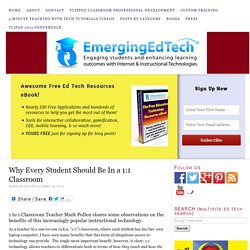
As a teacher in a one-to-one (a.k.a. “1:1”) classroom, where each student has his/her own laptop computer, I have seen many benefits that this form of ubiquitous access to technology can provide. The single most important benefit, however, is clear: 1:1 technology allows teachers to differentiate both in terms of how they teach and how the students are expected to demonstrate their learning. Let’s examine both of these advantages in more detail. Differentiation of Content Delivery In traditional instruction, not involving the use of technology, teaching and learning were typically undifferentiated. 5 Tech Savvy Teaching Tools That Your Students Will Love and Your Peers Will Envy — Emerging Education Technologies. These Fun, Free Web Applications Make it Quick and Easy to Create Cool Learning Content (Watch out Though, Other Teachers Will be Banging Down Your Door Looking for Tips).
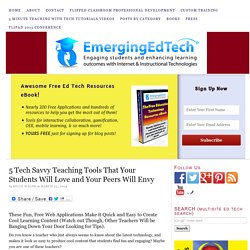
Do you know a teacher who just always seems to know about the latest technology, and makes it look so easy to produce cool content that students find fun and engaging? Maybe you are one of these teachers? It doesn’t have to be hard to use slick tech tools in the classroom. Graphic Organizers. Erikson's Theory of Psychosocial Development.
Exploring developmentally appropriate practice — Better Kid Care. As a practitioner caring for children, it is your responsibility to seek out and intentionally plan the best opportunities for children that support their over-all well being and healthy development.

The practices that you use when working with young children need to embrace the most current, effective approaches in learning and development. These can be described as best practices, thoughtful teaching, quality practices, or Developmentally Appropriate Practices (DAP). DAP comes from a deep history in early education, research, and what many describe as “good thinking.” Piaget's Stages of Cognitive Development. According to psychologist Jean Piaget, children progress through a series of four critical stages of cognitive development.

Each stage is marked by shifts in how kids understand the world. Developmental Characteristics of Young Adolescents. Early adolescence is a distinct period of human growth and development situated between childhood and adolescence.
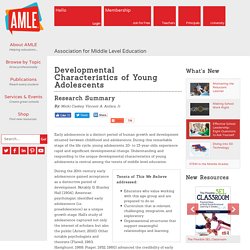
During this remarkable stage of the life cycle, young adolescents, 10- to 15-year-olds, experience rapid and significant developmental change. Understanding and responding to the unique developmental characteristics of young adolescents is central among the tenets of middle level education. Tenets of This We Believe addressed: Educators who value working with this age group and are prepared to do so Curriculum that is relevant, challenging, integrative, and exploratory Organizational structures that support meaningful relationships and learning During the 20th century, early adolescence gained acceptance as a distinctive period of development. Technology Integration Ideas that Work.
Technology has become integrated in the classroom in so many ways, that we often don't even think about how we are using it.

The Education World Tech Team offers lessons and activities to help educators make better use of technology tools for instruction, and to help students improve their technology skills within the context of the regular curriculum. Included: Integration activities that utilize the Web, PowerPoint, Excel, digital photography, SMART Boards, and more. In more and more schools today, technology is recognized as an instructional tool, not as a subject of instruction. Still, many educators, less familiar and less comfortable with technology than their students, struggle to seamlessly integrate a growing list of technology tools into their regular curriculum. "Using technology in the classroom is becoming easier for teachers," instructional technology consultant Jamye Swinford told Education World.
The Art of Managing Middle School Students. Squirrels.

That is what they remind me of. We were all that age once and we were all just like squirrels! Videos, Common Core Resources And Lesson Plans For Teachers: Teaching Channel. Symbaloo - Your Bookmarks and favorites in the cloud. Copyright Friendly Resources – TechnoPeterson. Reader's Theater Scripts and Plays for the Classroom. Reader's Theater Scripts and Plays Readers Theater is a dramatic presentation of a written work in a script form.
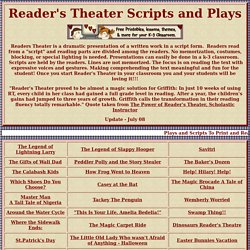
Readers read from a "script" and reading parts are divided among the readers. No memorization, costumes, blocking, or special lighting is needed. Presentations can easily be done in a k-3 classroom. Scripts are held by the readers. "Reader's Theater proved to be almost a magic solution for Griffith: In just 10 weeks of using RT, every child in her class had gained a full grade level in reading. Update - July 08. Testmoz - The Test Generator. PBS LearningMedia. Middle School Teaching: Tips, Strategies & Advice.
Bloom's Taxonomy. Home » WSM Help » Faculty Resources » Instructional Design And Delivery » Teaching and Pedagogy » Bloom's Taxonomy In 1956, Benjamin Bloom and some professional colleagues published a framework for categorizing educational goals and called it “Taxonomy of Educational Objectives”.
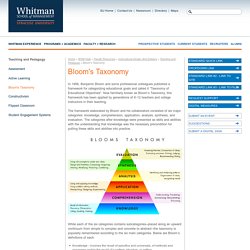
Now familiarly known as Bloom’s Taxonomy, this framework has been applied by generations of K-12 teachers and college instructors in their teaching. The framework elaborated by Bloom and his collaborators consisted of six major categories: knowledge, comprehension, application, analysis, synthesis, and evaluation. The categories after knowledge were presented as skills and abilities with the understanding that knowledge was the necessary precondition for putting these skills and abilities into practice.
Lev Vygotsky and Social Learning Theories. Instruction that supports social learning: Students work together on a task Students develop across the curriculum Instructors choose meaningful and challenging tasks for the students to work Instructors manage socratic dialogue that promote deeper learning. Vygotsky argued, "that language is the main tool that promotes thinking, develops reasoning, and supports cultural activities like reading and writing" (Vygotsky 1978). As a result, instructional strategies that promote literacy across the curriculum play a significant role in knowledge construction as well as the combination of whole class leadership, individual and group coaching, and independent learning.
Learning Theories & Theorists. Many Learning Theories have been developed over a long period of time, though a majority of those now in use have arisen in the last century or so. These theories apply to many different levels of educational learning. Several theories and theorists stand out among this group, many for quite different reasons. Not all theories or theorists are covered on this page. Academic Word List - Science. How to Increase Higher Order Thinking. Higher order thinking (HOT) is thinking on a level that is higher than memorizing facts or telling something back to someone exactly the way it was told to you. HOT takes thinking to higher levels than restating the facts and requires students to do something with the facts — understand them, infer from them, connect them to other facts and concepts, categorize them, manipulate them, put them together in new or novel ways, and apply them as we seek new solutions to new problems.
Answer children's questions in a way that promotes HOT Parents and teachers can do a lot to encourage higher order thinking, even when they are answering children's questions. According to Robert Sternberg, answers to children's questions can be categorized into seven levels, from low to high, in terms of encouraging higher levels of thinking. While we wouldn't want to answer every question on level seven, we wouldn't want to answer every question on levels one and two, either. Level 1: Reject the question.
The Jigsaw Classroom. How to Increase Higher Order Thinking. Free Online Quiz Maker. Our Quiz tool, part of GoConqr.com, was specifically designed to help you study and prepare you for exams. It enables you to test your own knowledge and practice exam questions. We have different question types that help keep you engaged and test what you’ve studied. Having this free tool at your disposable will greatly improve your chances of achieving exam success. To help you along the way we also have extensive sharing features so you and your friends can challenge each other. Association for Middle Level Education. Glo Bible: An Interactive Bible. Create and Explore Educational Content Online. Khan Academy.
CrashCourse. Socrative. Game-based blended learning & classroom response system. Khan Academy. Testmoz - The Test Generator. Reader's Theater Scripts and Plays for the Classroom. RubiStar Home. Audience Response Systems. Education World: Connecting educators to what works.
An Introduction to Technology Integration. The New Basics: Classroom Technology. Apps That Rise to the Top: Tested and Approved By Teachers. Michelle Luhtala/Edshelf With the thousands of educational apps vying for the attention of busy teachers, it can be hard to sift for the gold. Michelle Luhtala, a savvy librarian from New Canaan High School in Connecticut has crowd-sourced the best, most extensive list of apps voted on by educators around the country. “I wanted to make sure we had some flexibility because there’s no one app that’s better than all the others,” Luhtala said. Some apps are best for younger students, others are more complicated, better suited for high school students. Many apps do one thing really well, but aren’t great at everything. 30Hands allows a user to make pictures, annotate them, record a voice explainer and then packages it all into a video.
Adobe Voice is a recently released education product from Adobe that allows students to narrate a story over an array of digital images. Tellagami is a tool to share quick animated messages. ExplainEverything is another tool for creating video like tutorials. Classroom Management Tips For New Teachers Classroom Management Tips. RubiStar Home. National Geographic Education - National Geographic Education. This website would like to remind you: Your browser (Firefox 17) is out of date. A Resource Guide to Sixth Grade Lesson Plans. Written by: Janelle Cox • edited by: Wendy Finn • updated: 9/22/2012 Teaching 6th grade is a special challenge but very rewarding. This is the age where you can start teaching your students more challenging material.
Get ideas forming your curriculum with the following lesson plans.